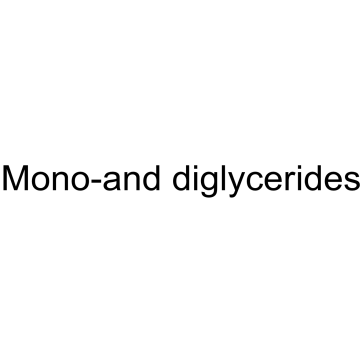Mono-and diglycerides |
| Catalog No.GC38821 |
Mono-and diglycerides is formed by triglycerides being broken down by pancreatic lipase in the gastrointestinal lumen.
Products are for research use only. Not for human use. We do not sell to patients.

Sample solution is provided at 25 µL, 10mM.
Mono-and diglycerides is formed by triglycerides being broken down by pancreatic lipase in the gastrointestinal lumen. Mono-and diglycerides is a food additive used as a nonionic emulsifier and mainly present in food fats[1][2].
Squalene and Mono-and diglycerides on the frying stability of olive pomace oil is determined. Refined olive pomace oil is distilled using a falling film type short-path distillation unit at 230℃ under a pressure of 0.02 mbar to remove minor components. Distilled olive pomace oil is introduced with approximately 10,000 mg/kg of squalene and 2.5% of Mono-and diglycerides. Fryings are performed 8 times/day at 180 °C for 3 min. All criteria except smoke point and iodine value increased in all fractions during fryings. The lowest total polar compound is obtained in distilled olive pomace oil while polymerized triglycerides is the lowest in the Mono-and diglycerides added fraction[3].
In the body, the triglycerides undergo digestion in the gastrointestinal lumen. Triglycerides are broken down mainly by pancreatic lipase with the formation of Mono-and diglycerides. Mono-and diglycerides are absorbed into the intestinal cells. In their passage through the intestinal mucosa Mono-and diglycerides are largely converted back into triglycerides. These pass into the body as a fine emulsion and give rise to the milky appearance of the chyle and the blood plasma. Under certain circumstances, these fat particles can be broken down by another fat-splitting enzyme in the blood-stream. When this occurs, the formation of Mono-and diglycerides can be demonstrated[1].
[1]. Toxicological evaluation of some food additives including anticaking agents, antimicrobials, antioxidants, emulsifiers and thickening agents. WHO FOOD ADDITIVES SERIES NO. 5. [2]. MasatoshiKako, et al. The stability of soybean oil-water emulsions containing mono- and diglycerides. Journal of Colloid and Interface Science. Volume 69, Issue 1, 15 March 1979, Pages 163-169. [3]. Sahin Ozkan K, et al. Utilization of molecular distillation for determining the effects of some minor compounds on the quality and frying stability of olive pomace oil. J Food Sci Technol. 2019 Jul;56(7):3449-3460.
Average Rating: 5 (Based on Reviews and 10 reference(s) in Google Scholar.)
GLPBIO products are for RESEARCH USE ONLY. Please make sure your review or question is research based.
Required fields are marked with *



















